
I recently spoke with three former employees of the world-famous airline, Pan Am. During its heyday, Pan Am was the marvel of the travel world. The airline almost singlehandedly ushered in the Jet Age, opened up America to much of the world (including remote destinations), and played an important role in not just passenger aviation, but also politics, war, and global affairs.
Here are three passionate former employees who share what it was like to work for “The World’s Most Experienced Airline”. Despite their varied tales, they all shared one thing in common: a love and respect for Pan Am. Throughout my interviews, I constantly heard of how wonderful it was to fly for Pan Am. How there was a genuine desire to be in the air, traversing the globe, and getting to know passengers. Below are a few of the harrowing, hilarious, and humble stories from Pan Am’s decades of service.
LINDA FREIRE (Flight Attendant)
One of my most memorable moments was on a flight that me and the rest of the crew refer to as “The Mutiny on the Bounty.” There’s a pretty popular tour company called Perillo Tours. They used to book large groups on Pan Am to fly to places like Italy and France. We were coming out of Paris and picked up a big Perillo Tours group. This charter flight was on a DC-10 plane that Pan Am got after acquiring National Airlines. It was also an airplane that we didn’t like. We used to say “If it ain’t Boeing, I ain’t going!” We were all very fond of our 747s, so already, the crew just wasn’t happy with the plane we were in. The DC’s just didn’t have the elegance of the 747, with her spiral staircase and large galleys. Flying them was just never the same.
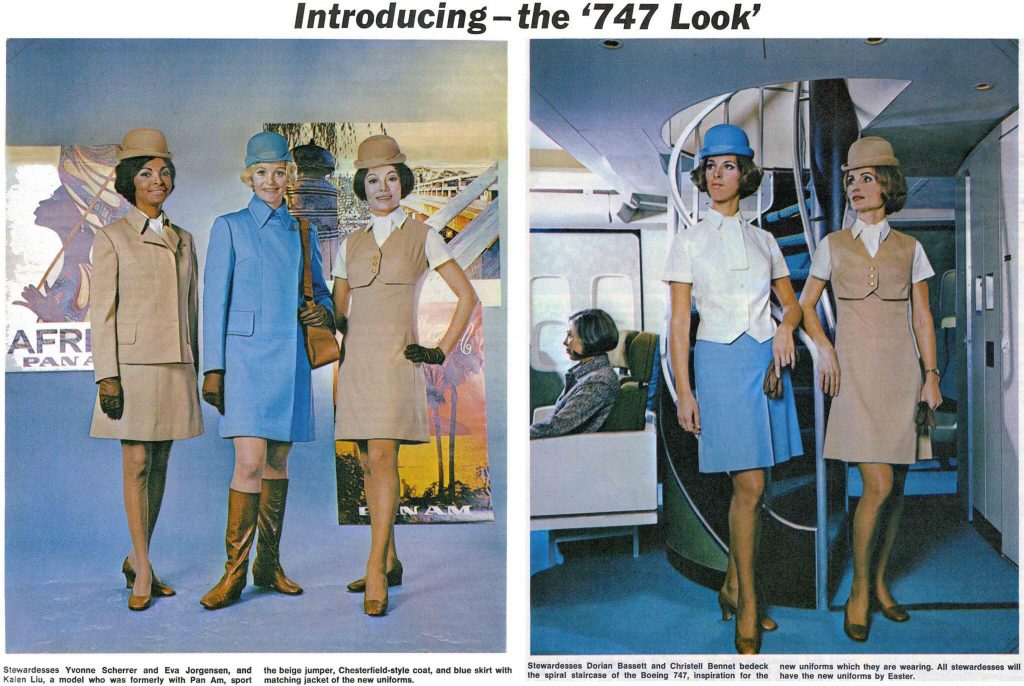
Pan Am Stewardesses from the 1970s
Anyways, so we take off from Paris and it’s kind of storming outside. Suddenly, there’s a lightning strike…and it hits the plane! The strike caused some of our equipment to malfunction, so the captain decided we needed to land and have the plane checked out. We had to circle the airport and dump fuel, then finally we come in for a landing. As we touchdown, there were firetrucks and stuff chasing the plane down the runway, even though nothing was critically wrong. It’s simply procedure for emergency landings.
After we arrive at the gate and have the plane looked at, our mechanic comes back and tells us that it’s going to be a long wait. We were at Charles da Gaulle, but the replacement part we needed was at Orly. They sent us over to some tiny airport hotel, we gave all the passengers food, and everything seemed to be going well. About six hours later, they tell us the plane is fixed. Naturally, everyone’s happy because we all think we’re going to be on our way back to New York.
So, we take off and start climbing into the air…and the same thing happens again. We’re forced to land once more, and people are starting to get really angry. It’s now late, and all of us crew know there’s no way the plane is getting fixed until the morning. And I just need to add in, this tour group was a bunch of people from Long Island…and I’m from Long Island, so I’m allowed to say this…they’re not the type of people who remain quiet when they’re unhappy. And since us stewardesses were the face of the airline, it was up to us to deal with all of them.
Furthermore, we never had problems like this on our 747s. So, at this point, some of the crew is starting to complain too, blaming the DC-10. That night at the hotel, there was a lot of anger and tension between everyone. Obviously, the passengers were pissed because it was a long, miserable day. And us crew were exhausted too. We tried to stay away from the passengers as much as possible that night because we knew that interactions could lead to altercations, and we didn’t want that happening.
The next day we headed back to the airport, and the whole crew is like, we need to do something to make these passengers happier. We were about to embark on a transatlantic flight with these people who were tired, angry, and blamed us for everything that had happened. We couldn’t have a 9-hour flight where everyone is completely miserable and tensions are running high. Fortunately, Pan Am did bring in a 747 for us, so we already had the advantage of a plane we were more familiar with.
Back in the day, there was a show called The Gong Show, and one of the characters on it was called the Unknown Comic. He would come on stage and perform with a paper bag over his head that had little eye and mouth holes cut out of it. To lighten the mood, we figured that we’d greet the passengers at the plane, all with paper bags on our heads, just like the Unknown Comic.
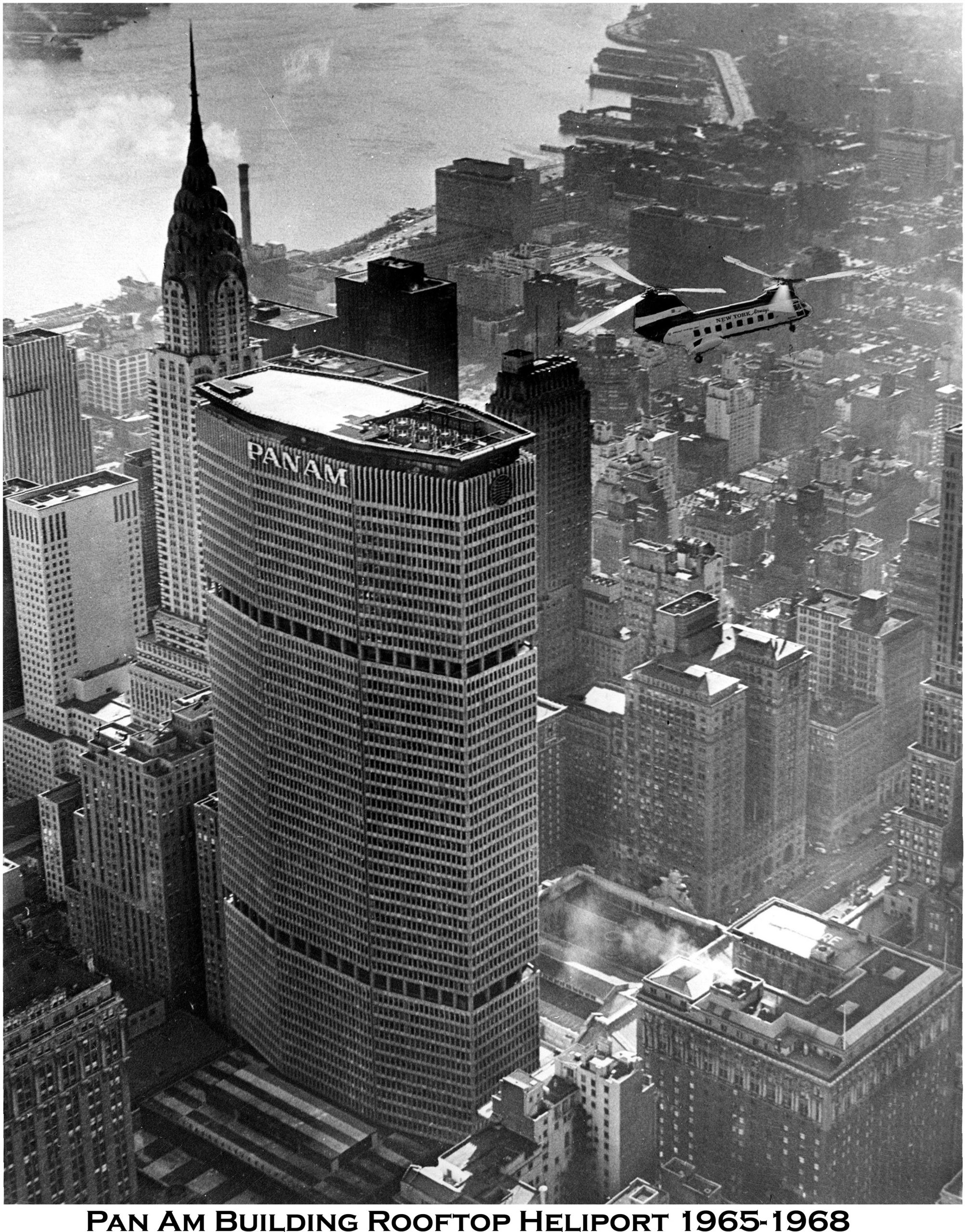
Pan Am Building (now the MetLife Building)
The second the passengers saw us, they started laughing. Some of them even asked, “When does the show start?” as they boarded. It was a great way to really help lower the tension for the flight back, and I think that even though it was a small gesture, it really made a huge difference.
When we finally got back to New York, we were shocked to see that there were police, ambulances, and media everywhere. There was even a headline in the New York Daily News that read ‘Last Rights Given on Pan Am 747 From Paris.’ We were completely shocked and had no idea what was going on. Some of the passengers must have called home during our overnight in Paris, telling their families that they were trapped in Europe because the plane had just been struck by lightning twice. Word somehow got out and the media heard about it, creating a frenzy back in America. So, yeah, that was quite the flight!
A Moment of Turbulence
I also had a moment during turbulence once that was pretty incredible. Sometimes you can hit a rogue bit of turbulence, and the plane can make a drastic drop, sometimes like 5,000 or even 10,000 feet. I was in the aisle serving coffee after dinner service. Back in those days, Pan Am always had a silver service, even in economy. I had a cart full of coffee with all the trimmings, like creams, sugars, mugs, and saucers, and in my hand, I’m holding a big pitcher of steaming hot coffee.
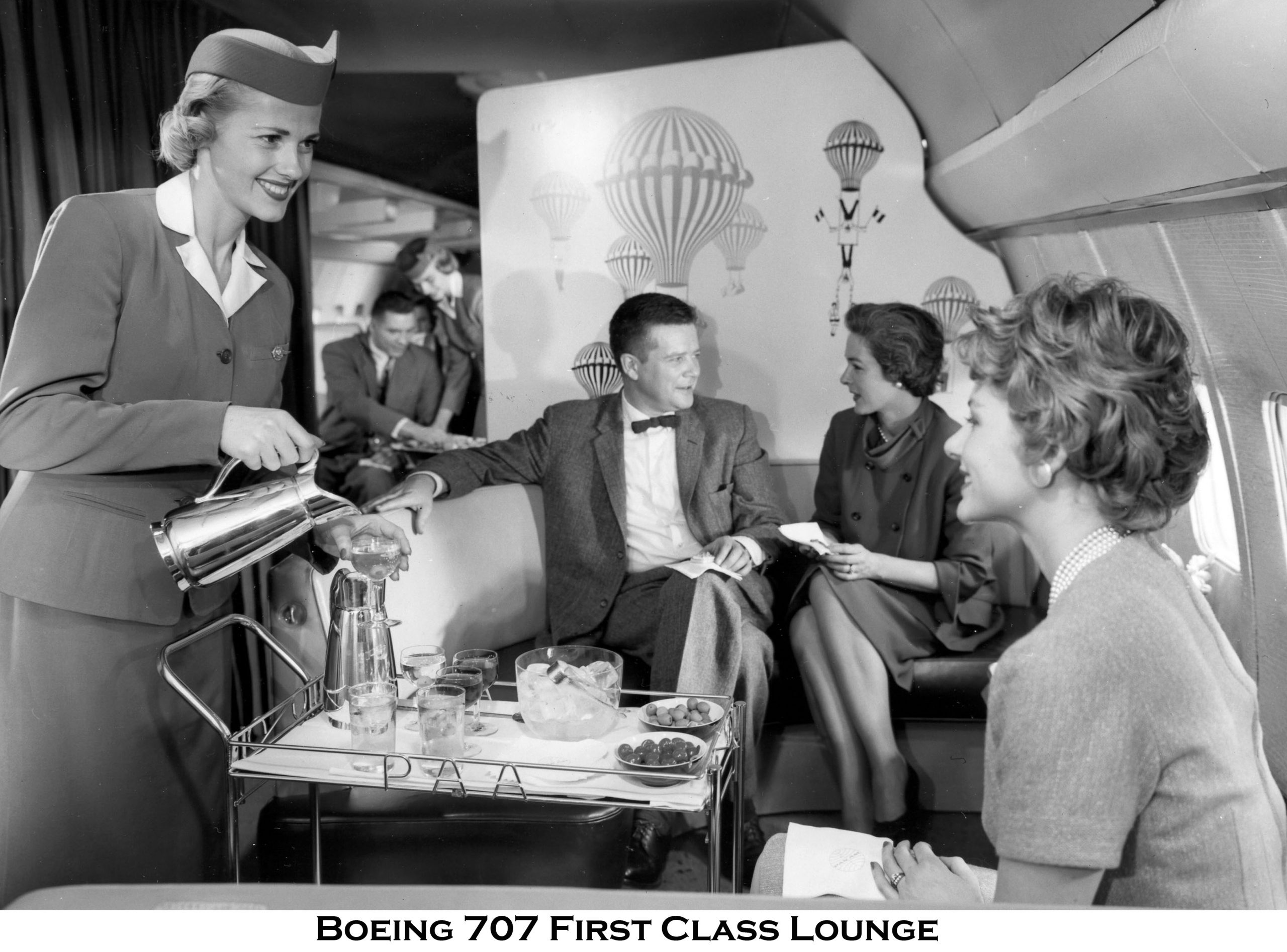
Drink service inside a Pan Am, circa 1960s
I’m telling you, one minute I’m pouring coffee, and then suddenly, the floor of the plane just drops. I’m now three feet off the aisle, floating in the air, still holding the coffee pitcher. As the plane levels out, I start falling back down the floor and the coffee flies up out of the pitcher, in a perfect cylinder. I land in the aisle, and the coffee falls back down, still in a seamless cylinder shape, directly back into the pitcher. It was incredible, and not a single drop of coffee was spilled. Everyone around me started applauding and cheering.
PHILLIP KEENE (Purser)
Back in 1988, I was brand new to the airline. I had probably only been flying for six months. This particular flight was my purser training flight, where a supervisor would be checking to see if I was qualified for the role. We were departing from the US, heading for Europe. And as we’re flying over the ocean, two of the 747’s four engines catch on fire. It wasn’t a huge emergency because the engine’s fire systems kicked in and extinguished the flames. But the captain still felt we needed to land at the nearest airport for maintenance. Because we were over the ocean, the closest one to us was actually behind us in Gander, Newfoundland.
At this point, I’m freaking out. I’m still new, trying to prove that I can be in charge, and here we are having to make an emergency landing. I quietly told the crew that we need to prepare for an emergency landing. Thankfully, everything went ok and we landed just fine. But because Gander isn’t a typical Pan Am destination, we had no garage or mechanics or replacement parts on hand. The solution turned out to be that the airline was going to simply send us a replacement plane instead of forcing us to wait for this one to be fixed.
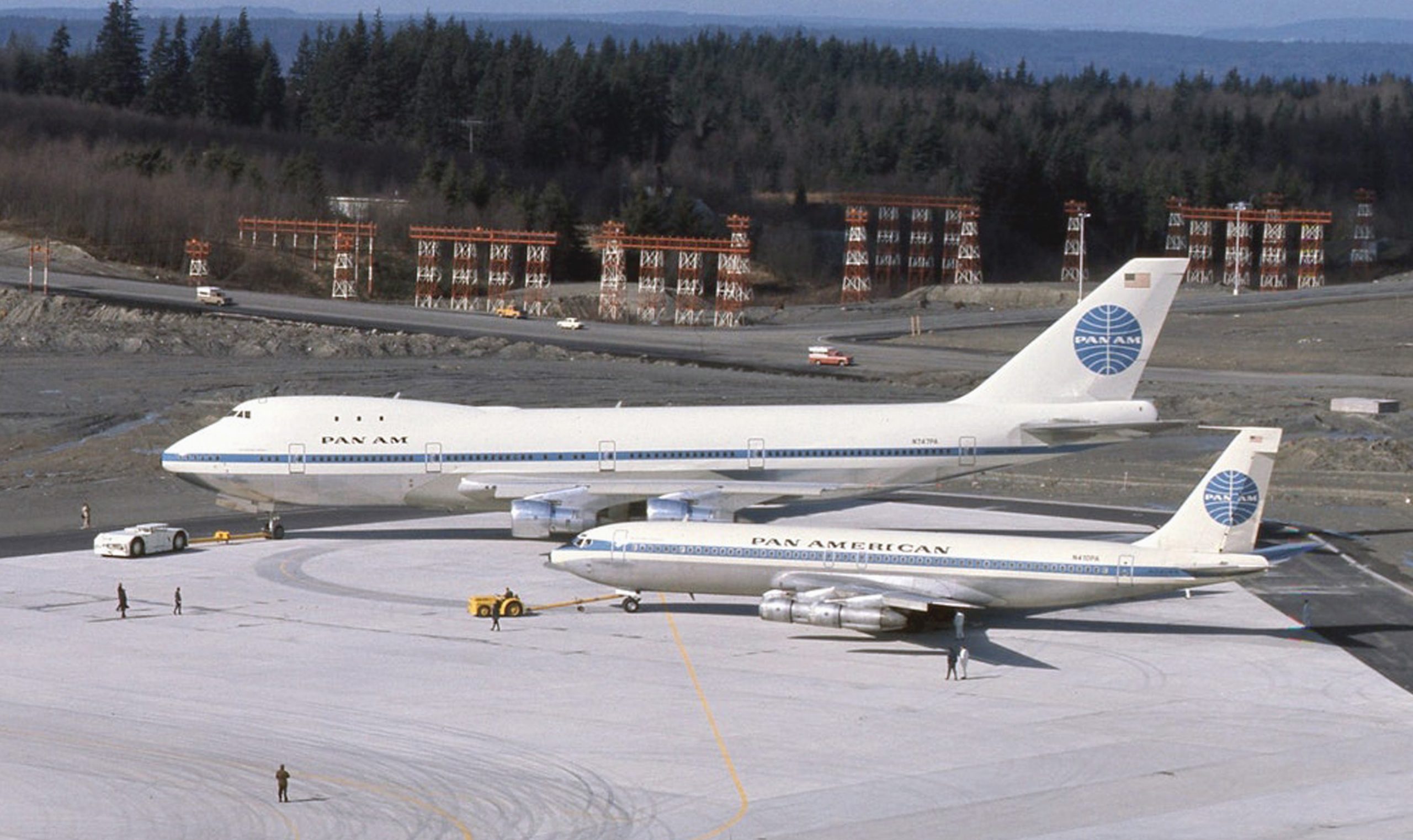
A Pan Am Boeing 747 and 707
Coincidentally, there also happened to be a random nursing convention happening in Gander, so the few hotels the town did have were completely booked up. Basically, we had nowhere to go. There was nowhere for us to put the passengers, nowhere for us crew to stay, and we couldn’t all just sit on the plane for hours. We were stranded. We ended up moving everyone into the airport and had to stay there until we could get our plane.
About 10 hours later, the new plane finally arrived. We got the plane prepped and got everyone on board…and then discovered we were missing two passengers. Now, unbeknownst to me, we initially had two passengers on board who were being deported from America back to the Middle East. Their passports had been handed to the other purser before boarding for safekeeping. I can’t speak for the other purser, so I don’t know what their reasoning was, but I come to find out that the purser had given these two their passports back as we deplaned everyone from the last aircraft.
We get word that these two have destroyed their passports and have decided they’re going to seek political asylum in Canada. And what’s worse is that we can’t leave until we know where these two are, because they’re technically our responsibility. So, I have to get on the PA and tell everyone that we can’t take off because we’re missing passengers, and of course, everyone is pissed. We had to wait for the Canadian government to tell us whether or not they would grant these two asylum, because if they didn’t, they’d still be our responsibility, and then we’d have a huge problem on our hands.
It was terrible. I had been awake for 17 hours, this was supposed to be my chance to prove myself, and now everything was going horribly wrong. Needless to say, I was a mess. Fortunately, Canada accepted them as asylum seekers, taking the responsibility out of our hands and allowing us to finally depart. Once we landed in London, the first thing my supervisor said to me was, “Did you remember to sign all your paperwork?”
Free Flights, Free Meals
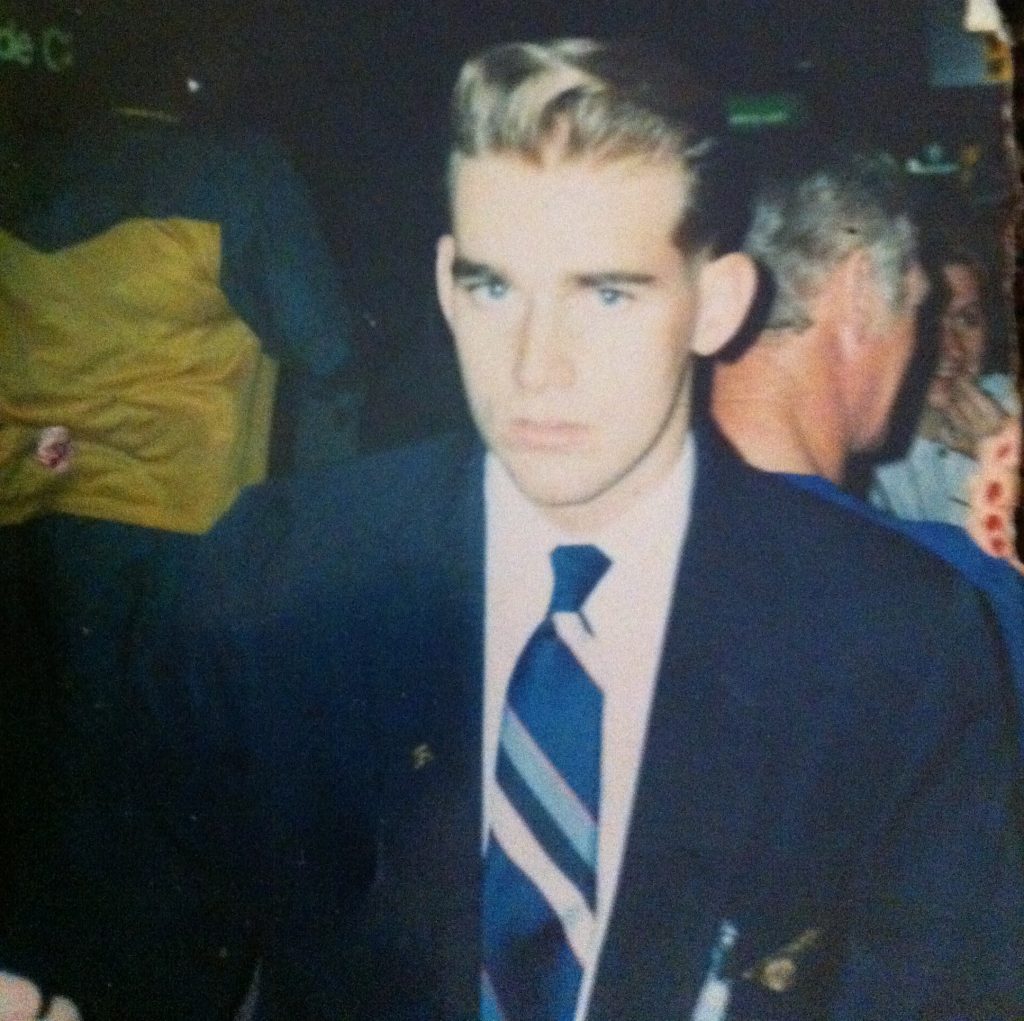
Phillip Keene arrives for work in the late 80s
When I first started, I was pretty broke. My first official week with Pan Am, before I had received a first paycheck or anything, was an open week for me. Which means that I wasn’t scheduled to work any flights. Back in those days, on our time off, we could fly for free to pretty much anywhere in the world. I couldn’t afford food or anything back then, but I knew that the planes served meals on flights. So, I decided that I’d eat every day by flying. Basically, I flew for five days straight, eating airline meals for breakfast, lunch, and dinner until my first paycheck came in.
It was really fun back then because we were basically handed blank tickets. You’d write your employee info on the lines and state where you wanted to go, and then you’d just head to the airport and wait for an open seat on a plane. It was a great way to see the world.
One time, back when I was based in Amsterdam, I accidentally left the keys to my apartment back in New York City. I was illegally subletting this apartment in Amsterdam, so I couldn’t tell the landlord about it, and I hardly spoke any Dutch, so there was no way I’d be able to communicate with a Dutch locksmith on the phone. The only option I had was to immediately head back to the airport, hop on a flight to America, grab my keys, which thankfully had been returned by someone to the lost and found desk, and then hop right back on another flight to Amsterdam.
JOHN MARSHALL (Pilot)
Back in the 60s, I used to do the R&R flights for the soldiers in Vietnam. Our crew was based in Hong Kong. We’d pick up soldiers in Vietnam and take them to places like Hong Kong, Taiwan, and Thailand for a week. It was to give them a break from the war, to help boost morale, and to simply provide them with some happiness and something to look forward to. We basically did these flights for free as well. If I recall correctly, Pan Am only charged the government cost plus one dollar.
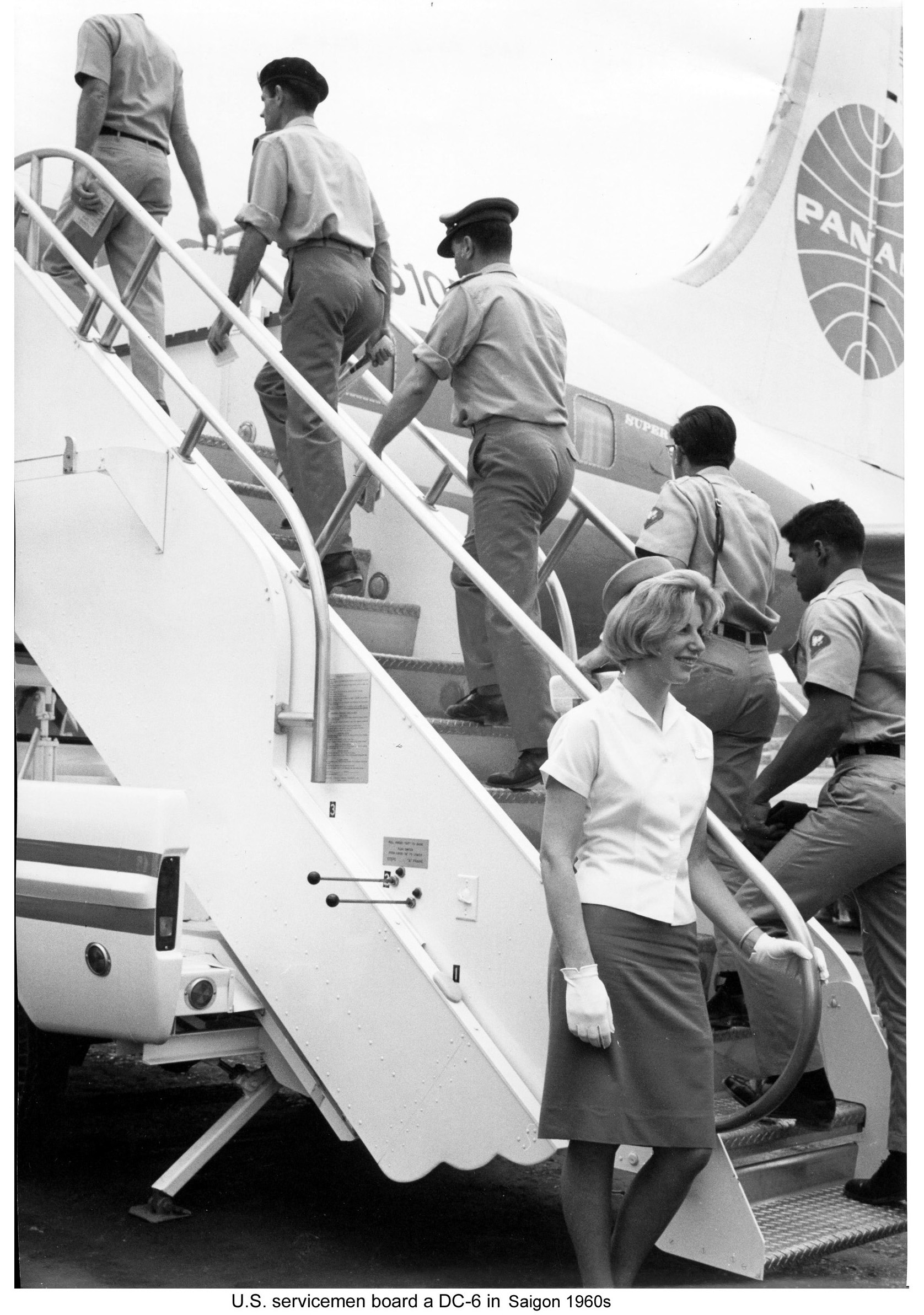
Pan Am R&R flight in Saigon
Operating these flights was incredibly surreal. We were civilians, flying into war zones to pick up soldiers. Sometimes, we’d come back to Hong Kong and find bullet holes in the bottom of the aircraft from where the Viet Cong shot at us.
When we’d land in Vietnam, we’d have to do what’s called a “canyon approach”, where you almost nosedive onto the runway at the last second in order to reduce the amount of time you spend in-air at a low altitude, which is where you’re most vulnerable to attack from ground fire.
Carrying troops out of Vietnam for R&R trips was unlike anything I’ve ever done again in my life. And our stewardesses on those flights were absolute dynamite. They were so good to those soldiers. The guys were served steak dinners with ice cream, and lots of drinks. I remember one flight, the stewardesses went on the PA and told the soldiers that to thank them for all their hard work, they were going to serve dessert topless. And obviously, this got a big reaction from everyone. Then they came up to the cockpit and grabbed our flight engineer and made him take his shirt off. They put a stewardess hat on him and had him walk up and down the aisle, serving desert. The soldiers had a field day with that one!
On the flip side, going the other way was a sobering experience. Seeing these young guys returning to war after spending five days in Hong Kong was really somber. Leaving Vietnam, they were laughing and having a great time. The flights felt like a party. But on the flights back to Vietnam, it was just silence. The difference between taking them out of Vietnam versus bringing them back was simply day and night. Which, I can’t blame them. I can’t imagine how difficult it must have been to go back to that.
Traversing the Iron Curtain
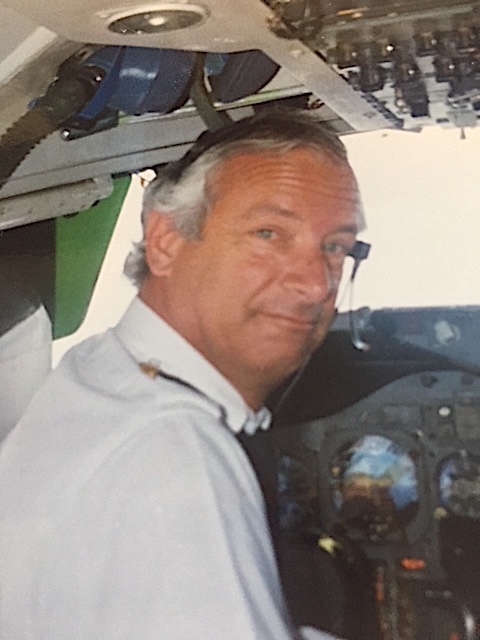
John Marshall in the cockpit of a Pan Am B747
After the R&R flights in Hong Kong, I was based in Berlin, West Berlin to be exact. At that time, Berlin was still behind the Iron Curtain and the wall was still up. It was totally isolated from the rest of the western world, but at the same time, it was also one of the most unique and outstanding cities anywhere.
All the occupying nations were allowed to designate one air carrier to provide access to West Berlin. So, Air France was France’s chosen carrier; BEA, which became British Airways, was Britain’s, and Pan Am was America’s. These air links were needed because traveling to West Berlin by car was just a mess.
Because Berlin was past the line of communist control, you’d need to apply for a visa, which could take weeks to get a response on. If you were granted access, you’d get a designated arrival time, and you’d have to be at the East German border at that exact time. Once you got there, they’d take your car apart. They’d check your trunk, pull your seats out, run mirrors underneath everything, and then physically check you too. Then you’d get a time stamp on your visa, which gave you a certain amount of allotted time to drive through East Germany to make it to West Berlin. If you arrived too fast, you’d get a fine for speeding. If you arrived late, you’d be turned around.
It was an incredibly unique and complex place to live, but there was also something exotic and exciting about it all as well. The culture and the art were just outstanding during that period. Berlin was a fantastic city. Probably one of the best in the world.
To learn more about the fascinating history of Pan Am, be sure to visit the Pan Am Museum Foundation, located just outside New York City.
If you want to join the Pan Am family, attend their upcoming fundraising gala on September 25th. Proceeds go to support the museum and foundation, and the yearly event is always a fun time. This year’s theme is ‘Flying Down to Rio’, paying homage to the 1933 film which prominently featured Pan Am’s flying boat service to Rio. Tickets are available on their website; $225 for the public, $200 for members. A ticket to the gala includes a cocktail hour beginning from 6:30 to 7:30 pm, followed by a sit-down dinner, entertainment, Silent Auction, Raffles, and dancing!
_______________________________________________
You May Also Like
Flight Attendants’ Insider Tips!
The post True Travel Tales: Pan Am Crew Members Share Their Favorite Stories appeared first on Passport Magazine.
True Travel Tales: Pan Am Crew Members Share Their Favorite Stories
I recently spoke with three former employees of the world-famous airline, Pan Am. During its heyday, Pan Am was the marvel of the travel world. The airline almost singlehandedly ushered in the Jet Age, opened up America to much of the world (including remote destinations), and played an important role in not just passenger aviation, but also politics, war, and global affairs.
Here are three passionate former employees who share what it was like to work for “The World’s Most Experienced Airline”. Despite their varied tales, they all shared one thing in common: a love and respect for Pan Am. Throughout my interviews, I constantly heard of how wonderful it was to fly for Pan Am. How there was a genuine desire to be in the air, traversing the globe, and getting to know passengers. Below are a few of the harrowing, hilarious, and humble stories from Pan Am’s decades of service.
LINDA FREIRE (Flight Attendant)
One of my most memorable moments was on a flight that me and the rest of the crew refer to as “The Mutiny on the Bounty.” There’s a pretty popular tour company called Perillo Tours. They used to book large groups on Pan Am to fly to places like Italy and France. We were coming out of Paris and picked up a big Perillo Tours group. This charter flight was on a DC-10 plane that Pan Am got after acquiring National Airlines. It was also an airplane that we didn’t like. We used to say “If it ain’t Boeing, I ain’t going!” We were all very fond of our 747s, so already, the crew just wasn’t happy with the plane we were in. The DC’s just didn’t have the elegance of the 747, with her spiral staircase and large galleys. Flying them was just never the same.

Pan Am Stewardesses from the 1970s
Anyways, so we take off from Paris and it’s kind of storming outside. Suddenly, there’s a lightning strike…and it hits the plane! The strike caused some of our equipment to malfunction, so the captain decided we needed to land and have the plane checked out. We had to circle the airport and dump fuel, then finally we come in for a landing. As we touchdown, there were firetrucks and stuff chasing the plane down the runway, even though nothing was critically wrong. It’s simply procedure for emergency landings.
After we arrive at the gate and have the plane looked at, our mechanic comes back and tells us that it’s going to be a long wait. We were at Charles da Gaulle, but the replacement part we needed was at Orly. They sent us over to some tiny airport hotel, we gave all the passengers food, and everything seemed to be going well. About six hours later, they tell us the plane is fixed. Naturally, everyone’s happy because we all think we’re going to be on our way back to New York.
So, we take off and start climbing into the air…and the same thing happens again. We’re forced to land once more, and people are starting to get really angry. It’s now late, and all of us crew know there’s no way the plane is getting fixed until the morning. And I just need to add in, this tour group was a bunch of people from Long Island…and I’m from Long Island, so I’m allowed to say this…they’re not the type of people who remain quiet when they’re unhappy. And since us stewardesses were the face of the airline, it was up to us to deal with all of them.
Furthermore, we never had problems like this on our 747s. So, at this point, some of the crew is starting to complain too, blaming the DC-10. That night at the hotel, there was a lot of anger and tension between everyone. Obviously, the passengers were pissed because it was a long, miserable day. And us crew were exhausted too. We tried to stay away from the passengers as much as possible that night because we knew that interactions could lead to altercations, and we didn’t want that happening.
The next day we headed back to the airport, and the whole crew is like, we need to do something to make these passengers happier. We were about to embark on a transatlantic flight with these people who were tired, angry, and blamed us for everything that had happened. We couldn’t have a 9-hour flight where everyone is completely miserable and tensions are running high. Fortunately, Pan Am did bring in a 747 for us, so we already had the advantage of a plane we were more familiar with.
Back in the day, there was a show called The Gong Show, and one of the characters on it was called the Unknown Comic. He would come on stage and perform with a paper bag over his head that had little eye and mouth holes cut out of it. To lighten the mood, we figured that we’d greet the passengers at the plane, all with paper bags on our heads, just like the Unknown Comic.

Pan Am Building (now the MetLife Building)
The second the passengers saw us, they started laughing. Some of them even asked, “When does the show start?” as they boarded. It was a great way to really help lower the tension for the flight back, and I think that even though it was a small gesture, it really made a huge difference.
When we finally got back to New York, we were shocked to see that there were police, ambulances, and media everywhere. There was even a headline in the New York Daily News that read ‘Last Rights Given on Pan Am 747 From Paris.’ We were completely shocked and had no idea what was going on. Some of the passengers must have called home during our overnight in Paris, telling their families that they were trapped in Europe because the plane had just been struck by lightning twice. Word somehow got out and the media heard about it, creating a frenzy back in America. So, yeah, that was quite the flight!
A Moment of Turbulence
I also had a moment during turbulence once that was pretty incredible. Sometimes you can hit a rogue bit of turbulence, and the plane can make a drastic drop, sometimes like 5,000 or even 10,000 feet. I was in the aisle serving coffee after dinner service. Back in those days, Pan Am always had a silver service, even in economy. I had a cart full of coffee with all the trimmings, like creams, sugars, mugs, and saucers, and in my hand, I’m holding a big pitcher of steaming hot coffee.

Drink service inside a Pan Am, circa 1960s
I’m telling you, one minute I’m pouring coffee, and then suddenly, the floor of the plane just drops. I’m now three feet off the aisle, floating in the air, still holding the coffee pitcher. As the plane levels out, I start falling back down the floor and the coffee flies up out of the pitcher, in a perfect cylinder. I land in the aisle, and the coffee falls back down, still in a seamless cylinder shape, directly back into the pitcher. It was incredible, and not a single drop of coffee was spilled. Everyone around me started applauding and cheering.
PHILLIP KEENE (Purser)
Back in 1988, I was brand new to the airline. I had probably only been flying for six months. This particular flight was my purser training flight, where a supervisor would be checking to see if I was qualified for the role. We were departing from the US, heading for Europe. And as we’re flying over the ocean, two of the 747’s four engines catch on fire. It wasn’t a huge emergency because the engine’s fire systems kicked in and extinguished the flames. But the captain still felt we needed to land at the nearest airport for maintenance. Because we were over the ocean, the closest one to us was actually behind us in Gander, Newfoundland.
At this point, I’m freaking out. I’m still new, trying to prove that I can be in charge, and here we are having to make an emergency landing. I quietly told the crew that we need to prepare for an emergency landing. Thankfully, everything went ok and we landed just fine. But because Gander isn’t a typical Pan Am destination, we had no garage or mechanics or replacement parts on hand. The solution turned out to be that the airline was going to simply send us a replacement plane instead of forcing us to wait for this one to be fixed.

A Pan Am Boeing 747 and 707
Coincidentally, there also happened to be a random nursing convention happening in Gander, so the few hotels the town did have were completely booked up. Basically, we had nowhere to go. There was nowhere for us to put the passengers, nowhere for us crew to stay, and we couldn’t all just sit on the plane for hours. We were stranded. We ended up moving everyone into the airport and had to stay there until we could get our plane.
About 10 hours later, the new plane finally arrived. We got the plane prepped and got everyone on board…and then discovered we were missing two passengers. Now, unbeknownst to me, we initially had two passengers on board who were being deported from America back to the Middle East. Their passports had been handed to the other purser before boarding for safekeeping. I can’t speak for the other purser, so I don’t know what their reasoning was, but I come to find out that the purser had given these two their passports back as we deplaned everyone from the last aircraft.
We get word that these two have destroyed their passports and have decided they’re going to seek political asylum in Canada. And what’s worse is that we can’t leave until we know where these two are, because they’re technically our responsibility. So, I have to get on the PA and tell everyone that we can’t take off because we’re missing passengers, and of course, everyone is pissed. We had to wait for the Canadian government to tell us whether or not they would grant these two asylum, because if they didn’t, they’d still be our responsibility, and then we’d have a huge problem on our hands.
It was terrible. I had been awake for 17 hours, this was supposed to be my chance to prove myself, and now everything was going horribly wrong. Needless to say, I was a mess. Fortunately, Canada accepted them as asylum seekers, taking the responsibility out of our hands and allowing us to finally depart. Once we landed in London, the first thing my supervisor said to me was, “Did you remember to sign all your paperwork?”
Free Flights, Free Meals

Phillip Keene arrives for work in the late 80s
When I first started, I was pretty broke. My first official week with Pan Am, before I had received a first paycheck or anything, was an open week for me. Which means that I wasn’t scheduled to work any flights. Back in those days, on our time off, we could fly for free to pretty much anywhere in the world. I couldn’t afford food or anything back then, but I knew that the planes served meals on flights. So, I decided that I’d eat every day by flying. Basically, I flew for five days straight, eating airline meals for breakfast, lunch, and dinner until my first paycheck came in.
It was really fun back then because we were basically handed blank tickets. You’d write your employee info on the lines and state where you wanted to go, and then you’d just head to the airport and wait for an open seat on a plane. It was a great way to see the world.
One time, back when I was based in Amsterdam, I accidentally left the keys to my apartment back in New York City. I was illegally subletting this apartment in Amsterdam, so I couldn’t tell the landlord about it, and I hardly spoke any Dutch, so there was no way I’d be able to communicate with a Dutch locksmith on the phone. The only option I had was to immediately head back to the airport, hop on a flight to America, grab my keys, which thankfully had been returned by someone to the lost and found desk, and then hop right back on another flight to Amsterdam.
JOHN MARSHALL (Pilot)
Back in the 60s, I used to do the R&R flights for the soldiers in Vietnam. Our crew was based in Hong Kong. We’d pick up soldiers in Vietnam and take them to places like Hong Kong, Taiwan, and Thailand for a week. It was to give them a break from the war, to help boost morale, and to simply provide them with some happiness and something to look forward to. We basically did these flights for free as well. If I recall correctly, Pan Am only charged the government cost plus one dollar.

Pan Am R&R flight in Saigon
Operating these flights was incredibly surreal. We were civilians, flying into war zones to pick up soldiers. Sometimes, we’d come back to Hong Kong and find bullet holes in the bottom of the aircraft from where the Viet Cong shot at us.
When we’d land in Vietnam, we’d have to do what’s called a “canyon approach”, where you almost nosedive onto the runway at the last second in order to reduce the amount of time you spend in-air at a low altitude, which is where you’re most vulnerable to attack from ground fire.
Carrying troops out of Vietnam for R&R trips was unlike anything I’ve ever done again in my life. And our stewardesses on those flights were absolute dynamite. They were so good to those soldiers. The guys were served steak dinners with ice cream, and lots of drinks. I remember one flight, the stewardesses went on the PA and told the soldiers that to thank them for all their hard work, they were going to serve dessert topless. And obviously, this got a big reaction from everyone. Then they came up to the cockpit and grabbed our flight engineer and made him take his shirt off. They put a stewardess hat on him and had him walk up and down the aisle, serving desert. The soldiers had a field day with that one!
On the flip side, going the other way was a sobering experience. Seeing these young guys returning to war after spending five days in Hong Kong was really somber. Leaving Vietnam, they were laughing and having a great time. The flights felt like a party. But on the flights back to Vietnam, it was just silence. The difference between taking them out of Vietnam versus bringing them back was simply day and night. Which, I can’t blame them. I can’t imagine how difficult it must have been to go back to that.
Traversing the Iron Curtain

John Marshall in the cockpit of a Pan Am B747
After the R&R flights in Hong Kong, I was based in Berlin, West Berlin to be exact. At that time, Berlin was still behind the Iron Curtain and the wall was still up. It was totally isolated from the rest of the western world, but at the same time, it was also one of the most unique and outstanding cities anywhere.
All the occupying nations were allowed to designate one air carrier to provide access to West Berlin. So, Air France was France’s chosen carrier; BEA, which became British Airways, was Britain’s, and Pan Am was America’s. These air links were needed because traveling to West Berlin by car was just a mess.
Because Berlin was past the line of communist control, you’d need to apply for a visa, which could take weeks to get a response on. If you were granted access, you’d get a designated arrival time, and you’d have to be at the East German border at that exact time. Once you got there, they’d take your car apart. They’d check your trunk, pull your seats out, run mirrors underneath everything, and then physically check you too. Then you’d get a time stamp on your visa, which gave you a certain amount of allotted time to drive through East Germany to make it to West Berlin. If you arrived too fast, you’d get a fine for speeding. If you arrived late, you’d be turned around.
It was an incredibly unique and complex place to live, but there was also something exotic and exciting about it all as well. The culture and the art were just outstanding during that period. Berlin was a fantastic city. Probably one of the best in the world.
To learn more about the fascinating history of Pan Am, be sure to visit the Pan Am Museum Foundation, located just outside New York City.
If you want to join the Pan Am family, attend their upcoming fundraising gala on September 25th. Proceeds go to support the museum and foundation, and the yearly event is always a fun time. This year’s theme is ‘Flying Down to Rio’, paying homage to the 1933 film which prominently featured Pan Am’s flying boat service to Rio. Tickets are available on their website; $225 for the public, $200 for members. A ticket to the gala includes a cocktail hour beginning from 6:30 to 7:30 pm, followed by a sit-down dinner, entertainment, Silent Auction, Raffles, and dancing!
_______________________________________________
You May Also Like
Flight Attendants’ Insider Tips!
The post True Travel Tales: Pan Am Crew Members Share Their Favorite Stories appeared first on Passport Magazine.


Post a Comment